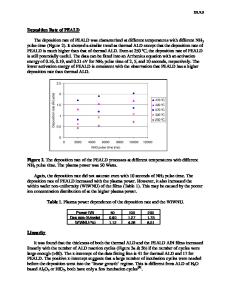Atomic layer deposition of tungsten disulphide solid lubricant thin films
- PDF / 719,201 Bytes
- 4 Pages / 612 x 792 pts (letter) Page_size
- 113 Downloads / 428 Views
Atomic layer deposition of tungsten disulphide solid lubricant thin films T.W. Scharf, S.V. Prasad, T.M. Mayer, R.S. Goeke, and M.T. Dugger Sandia National Laboratories, Albuquerque, New Mexico 87185 (Received 6 July 2004; accepted 27 August 2004)
The synthesis and characterization of crystalline tungsten disulphide (WS2) solid lubricant thin films grown by atomic layer deposition (ALD) using WF6 and H2S gas precursors was studied. A new catalytic route was established to promote nucleation and growth of WS2 films on silicon surfaces with native oxide. Scanning electron microscopy with energy dispersive spectroscopy and Raman spectroscopy were used to determine the film morphology, composition, and crystallinity. The films exhibited solid lubricating behavior with a steady-state friction coefficient of 0.04 in a dry nitrogen environment.
Atomic layer deposition (ALD) was first developed in the 1970s for thin film electroluminescent (TFEL) flat panel displays.1,2 Since then ALD has found niche applications in microelectronics, optics, protective coatings, and gas sensors.3,4 Atomic layer deposition is a chemical vapor deposition technique based on sequential introduction of gaseous precursors and selective surface chemistry to achieve controlled growth of a film at the atomic scale. Efficient transport of material into confined spaces at low pressure, and sequential introduction of reactants leads to inherently excellent control of film thickness and coverage of high aspect ratio structures. This makes it ideally suited for coating shadowed surfaces on the underside of moving mechanical assemblies such as microelectromechanical systems (MEMS). Members of our group5 have recently reported that 10-nm-thick ALD Al2O3 films deposited onto high aspect ratio surface micromachined silicon MEMS microengines are highly conformal. The friction coefficient of silicon (measured against a Si3N4 counterface in a ballon-flat configuration) was reduced from approximately 0.7 to 0.3 as a result of the ALD Al2O3 film. Similarly, Hoivik et al.6 deposited 80-nm-thick ALD Al2O3 films on MEMS cantilever beams and determined the films were highly conformal using cross-sectional scanning electron microscopy. However, there is a need for solid lubricant materials for MEMS devices that can provide friction coefficients of approximately 0.05 and wear life
DOI: 10.1557/JMR.2004.0459
of millions of cycles. The objective of our study was to synthesize tungsten disulfide (WS2) solid lubricant films by ALD and evaluate their microstructure and tribological (friction and wear) behavior. Tungsten disulfide is a well-known solid lubricant belonging to the family of transition metal dichalcogenides MX2 (M ⳱ W, Mo; X ⳱ S, Se). In the past, physical vapor deposition (PVD) techniques such as sputtering and pulsed laser deposition,7–12 as well as chemicalvapor-deposition (CVD) techniques13,14 have been successfully used to grow WS2 solid lubricant films. PVD techniques by virtue of their line-of-sight nature are not capable of conformally coating high
Data Loading...










